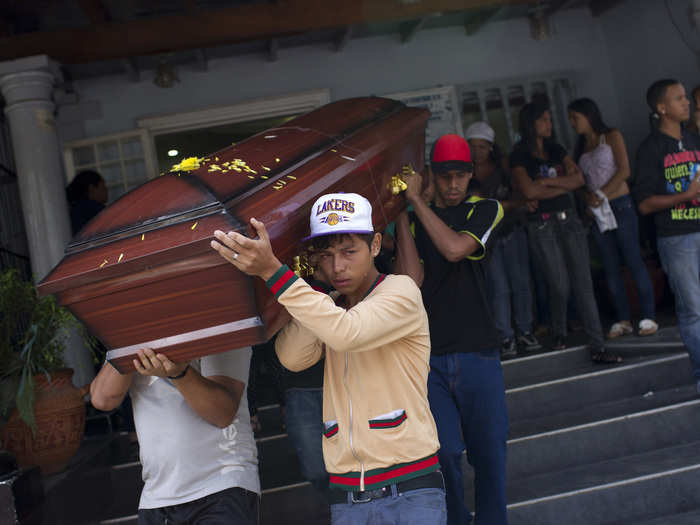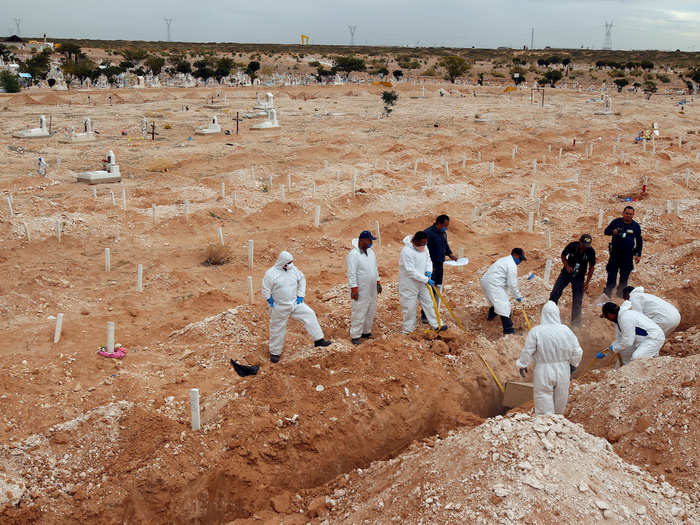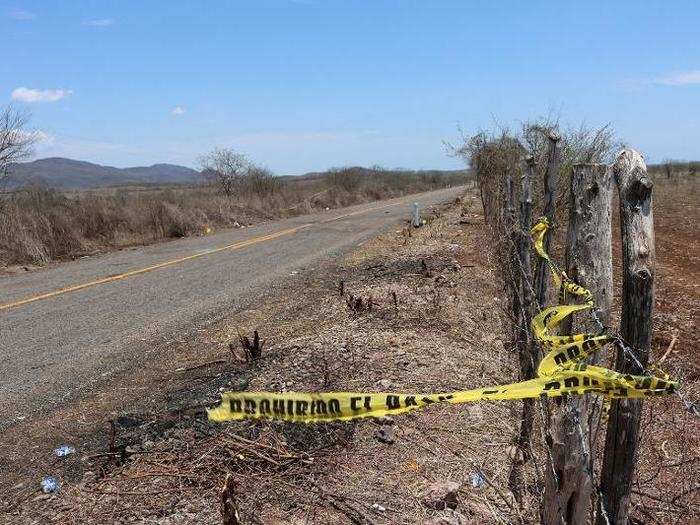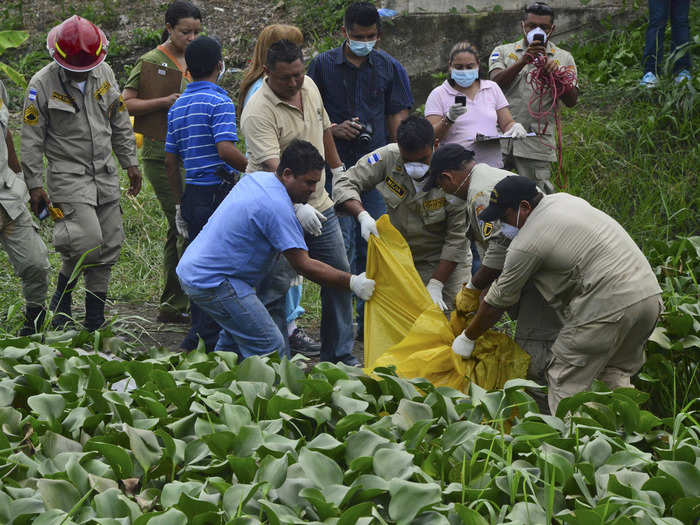- Home
- slideshows
- miscellaneous
- 3 big reasons why it's so hard to tell just how violent the world's most violent cities are
3 big reasons why it's so hard to tell just how violent the world's most violent cities are
Where did it happen?

3 big reasons why it's so hard to tell just how violent the world's most violent cities are

The Mexican group adheres to some set criteria, requiring minimum population of 300,000 people and excluding places with active conflicts, like Ukraine or Syria.
But, the group says in its methodology, whenever possible it includes all the municipalities that it assess as part of a city — "localities that form a unique urban system, clearly distinguishable from others, independent of the geographic-administrative divisions inside the countries."
Muggah and his colleagues noted issues with this method in relation to the 2015 ranking, which found Caracas to be the most violent city in the world. That year, others also noted the group based its tally on the homicide total for the metropolitan area of Cali, in southwest Colombia, and, in their view, overstated the number of homicides.
The group's ranking for 2018, its most recent, put Tijuana at the top of the list, with a homicide rate of 138.26 per 100,000.
Tijuana has seen a precipitous rise in deadly violence, but the city's public-security secretary disputed its rank, citing the inclusion of the nearby city of Rosarito in the homicide count and the failure to account for Tijuana's migrant population.
SJP, for its part, rejected the criticism, saying that it based its population count on official numbers and that excluding Rosarito would have actually raised the homicide rate. (Though it did not say why it assessed Tijuana's metropolitan area and not that of other cities.)
What's a homicide?

"It turns out there are many kinds of homicide," Muggah said. "We have homicide that's intentional. We have homicide that's unintentional, which we also call manslaughter. We have homicide committed by police, which sometimes isn't included in the formal homicide statistics."
Mexico has experienced an alarming increase in homicides, setting new records in 2017 and 2018.
Mexico's official crime data includes two categories for homicide: "homicidio doloso," which refers to intentional homicides, and "homicidio culposo," which refers to manslaughter or unintentional homicides.
The most recent tallies for intentional homicides in Mexico in 2017 and 2018 are 28,868 and 33,369, respectively. The totals for all homicides are 46,640 in 2017 and 50,373 in 2018.
3 big reasons why it's so hard to tell just how violent the world's most violent cities are

While official government tabulations distinguish between unintentional and intentional homicides as they are legally defined in those countries, counts by nongovernmental groups, the media, or the public can elude that distinction, lumping different kinds of lethal violence together.
"And that matters," Muggah said, "because in some countries, including Mexico and Brazil, when you include police lethality, police killings, which fall under a different category, that can actually significantly augment the overall count."
In many cases, Muggah added, "those deaths are not what you describe as illegal."
In 2017, Brazil had 63,880 homicides — 175 people killings a day on average — up 3% from 2016 and a new record. (Homicides were trending downward through the first nine months of 2018, but full-year data for 2018 is not yet available.)
2017 also saw an increase in the number of people killed by Brazil's police, rising 20% from 2016 to 5,144 people, or 14 a day on average. Authorities in Rio de Janeiro state have attracted special scrutiny for their lethality, drawing accusations of extrajudicial executions.
Not only where and how you measure, but when?

Even when homicide data for a full calendar year is available — which is not always the case; the SJP list in some cases extrapolates from partial-year data — it may change over time.
"In many cases, there are outstanding trials and judicial processes that are ongoing to determine ... what in fact that lethal outcome was, and that can take months. It can take years," Muggah said. "Typically though, there's a delay when governments produce data to issue this information, because they're still dealing with many of the legalities around sorting out homicide."
Full-year 2017 crime data for Mexico, first released in January 2018, put the number of homicide victims at 29,168.
The most recent data for that year, updated in March 2019, indicates there were 28,868 homicide victims. (The Mexican government changed its methodology at the beginning of 2018 and updated previous tallies to reflect that.)
3 big reasons why it's so hard to tell just how violent the world's most violent cities are

There are also 26,000 unidentified bodies in Mexico's forensic system, and the government estimates that more than 40,000 people are missing. Hidden graves full of unidentified bodies are frequently found all around Mexico.
All of that — coupled with issues like a lack of prosecution and suspicions about officials manipulating crime data — mean Mexico's homicide totals are subject to change for the foreseeable future.
"In many countries, Latin America in particular, there are huge impunity rates and a great gap in processing some of these cases, precisely because of the volume but also the lack of capacity to go through all of these cases, and so there's a reason" for a delay, Muggah said.
It's necessary to reflect on violence and trends in crime, but, Muggah added, "the challenge is that many governments are operating at different speeds."
Relaying on data for only part of a year, or only drawing on certain sources that are readily available can often "unintentionally bias our sample," Muggah said.
Know what you don't know.

A challenge for "all of us who are in the business of monitoring and tracking and building systems to better understand criminality is that there are many places or instances where crime, including lethal violence, is not particularly well reported, or if it is reported it's reported very badly," Muggah said.
Latin American countries release crime data fairly regularly, but closer examination reveals "great gaps in the data," especially in parts of Venezuela, Mexico, and Brazil, Muggah said.
"There'll be reports that ... don't accurately capture the cause of death and therefore you get misattribution. There'll be a situation where they just can't story the bodies because there's insufficient space, and so you get undercounts," he said. "There'll be places where the governments themselves, police in particular, have no incentive to report on lethal violence and therefore will skew the figures."
Outside of the Organization of Economic Cooperation and Development, a 36-member group that includes most of North America and Europe, available information about crime is also lacking, Muggah said.
"If you go to Africa, with the exception of a few countries, it's ... a knowledge gap around homicide," he added. That's also the case in parts of Asia, "where governments just don't want to report overall statistics on crime, citing it as a national security issue."
Incentivizing cities.

In the methodology included in its most recent report, Security, Justice, and Peace states that it compiles the ranking with the objective of "calling attention to violence in cities, particularly in Latin America, so that the leaders are pressured to to fulfill their duty to protect the governed [and] to guarantee their right to public security."
"What we are also looking for is that no one ... wants their city or cities to appear in this ranking, and that if their city or cities are [on it] already, they make the maximum effort so they leave it as soon as possible," the group adds.
There are positive and negative potential effects of inclusion on such a list, Muggah said.
"One hopes that as a positive outcome [inclusion] would incentivize city leaders, business leaders in cities, civic activists, and common citizens to be alert to the many risks that are there and also to seek and strive to find ways to get themselves off that list," he said.
Stigmatizing cities.

But there can be negative consequences. Reducing a complicated issue like personal security to a single metric risks sensationalizing the problem and can skew public perceptions, potentially empowering leaders who push hardline, punitive responses, Muggah said.
In some cases, it can "stigmatize cities," Muggah said, affecting foreign and domestic investment, credit ratings, and business decisions. It can also have a particular effect on local economies, especially for tourism, on which many parts of Latin America rely.
"The hope is that by shining a light ... on these challenges that somehow this will provoke" a constructive response from the city, its residents, and its leaders, rallying them around a common goal, like reducing insecurity and getting off that list, Muggah said.
"It's not clear yet if that in fact has ever happened, whether these lists have contributed positively to social change, and that might be asking too much of a list," Muggah said.
Popular Right Now
Popular Keywords
Advertisement